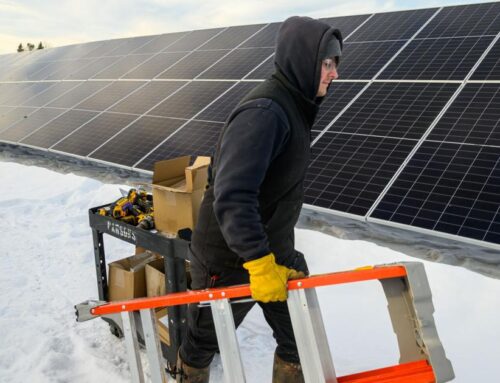Just How Endangered is Clean Energy?
March 31, 2025
Just How Endangered is Clean Energy?
The Trump administration wants to slow the U.S. clean energy transition. Will it put energy investments in a deep freeze or a temporary chill?
Business investment decisions rely on stability. And stability is in short supply so far in this Trump administration. Instead, we’ve seen an erratic blitzkrieg of activity on tariffs, federal funding, and deregulation that has spooked all sorts of industries. That’s partly why Heatmap News has declared Trump “Degrowth Donald,” and why my Legal Planet colleague Jonathan Zasloff has cheered the tariffs as a stupid but potentially effective way to reduce emissions.
But the administration is also, purposefully, impacting investments in critical clean energy infrastructure and manufacturing. To get a sense of how the industry is reacting, I asked Allan Marks, my UCLA colleague. Marks is a lecturer at the UCLA Law and UC Berkeley Law school, as well as a Senior Fellow at the Columbia Center on Sustainable Investment, a joint center of the law and climate schools at Columbia University.
Q: Renewables have seen a chill since the November election made chillier still by various Trump executive orders. How would you describe the current state of the industry?
A: Investment in renewable energy remains robust, at least for now. Most of the projects that are closing financing or under construction in 2025 already have permits, offtake power sales arrangements, site control and interconnection access well in hand. Deal volumes remain strong, including for the tax equity transactions that enable developers to monetize tax credits to reduce the capital requirements to build new geothermal, wind, solar and storage projects. At least for now, the investment tax credit and production tax credit remain the law of the land, and the existing guidance from the Treasury Department and other agencies continues to support tax equity investments and tax credit transfers.
The medium-term pipeline for renewable energy projects in the US is murkier, especially for projects that are dependent on federal permits or that need access to federal lands or waters in the outer continental shelf. The Trump Administration has come out hard criticizing renewable energy (other than geothermal energy, which they support), mainly against wind energy. Solar power and energy storage dominate interconnection queues and remain in accelerated growth mode (especially in large, growing states like Texas and California).
The reasons are simple: wind and solar power are less costly and more quickly deployed than alternatives fueled by natural gas or coal. The levelized cost of energy for wind and solar power is now competitive – and often lower than – fossil fuels. The lead time to buy and install equipment is far shorter. Customers, whether utilities or corporate buyers, need power now to accommodate huge demand growth from new data centers, other digital infrastructure and EVs. Waiting at least 7-9 years to permit a new natural gas combined cycle or peaker power plant, when turbines and other equipment are backordered into the next decade, will not solve that problem and, even if it did, it would be too costly compared to wind and solar. When coupled with storage, intermittent renewables are highly reliable at utility scale. Economics will trump politics here, so long as demand growth remains robust and supply chains and project costs are not too adversely affected by tariffs, inflation and regulatory uncertainty.
Q: You’ve previously done work on wind energy deals. What’s your outlook for offshore wind projects in California, as compared to say East Coast projects?
A: We are a long way from developing our first commercial offshore wind project in California. That may be good in a way for the developers of those projects, as they would not have expected to complete the federal permitting process in the near term. Hence, the pause on offshore wind leases and permitting reviews under the current Trump Administration could delay the projects but might not result in denial of any permits that would have been near completion. Offshore wind energy project on the US East Coast that are more advanced on their development schedule are more vulnerable to delay or cancelation if permits are not issued promptly or if environmental reviews are reopened or challenged.
In California, the Bureau of Ocean Energy Management (BOEM) announced winners of five offshore wind leases in 2022, with the potential to power over 1.5 million homes. These are notoriously complicated, long-lead time projects. Permits are only part of the picture. In California’s deep offshore water, innovative floating wind turbine designs are needed. Onshore landing sites, port facilities and transmission lines are needed. Specialized vessels are hard to find in the United States for offshore wind generally. And tariffs, inflation and interest rates add even more uncertainty.
Q: I wrote two years ago that the Inflation Reduction Act wouldn’t be repealed, invoking Easter peeps as a metaphor. But politics in 2025 is pretty different from what many imagined. Any predictions for what might happen to the IRA?
A: I don’t expect a repeal of the IRA’s energy provisions. There probably are not sufficient votes in either the House of the Senate for that, and 60% of all IRA-related clean economy projects – and 85% of total announced private-sector investments (as of 2024) – have gone to Republican congressional districts, despite the fact that no Republican member of Congress voted in favor of the IRA. In fact, 19 of the top 20 congressional districts for clean energy investments are held by Republicans.
Before the last federal election, on August 6, 2024, 18 House Republicans wrote a letter to House Speaker Mike Johnson seeking to preserve the IRA, echoed on March 10, 2025 by a letter that 21 House Republicans wrote to the House Ways & Means Committee (as it deliberated the budget) to preserve the IRA’s energy incentives in the name of furthering President Trump’s espoused goal of “energy dominance.”
All that said, I would watch to see what happens this summer with a new tax bill to extend the existing 2017 cuts to corporate and high-income tax rates, which are set to expire this year. Depending on how budget scoring is done, tax credits could be vulnerable. And any reduction of the US federal corporate income tax rate (proposed to be cut from 21% to 15% in recent Republican talking points) would undermine the value and attractiveness of tax credits, especially if coupled with a recession.
Allan Marks can be contacted by email: marks@law.ucla.edu
Search
RECENT PRESS RELEASES
Related Post



